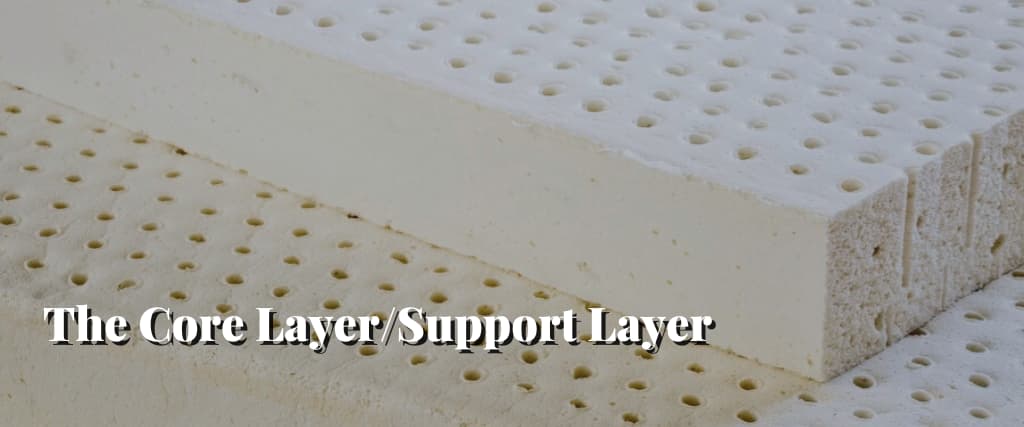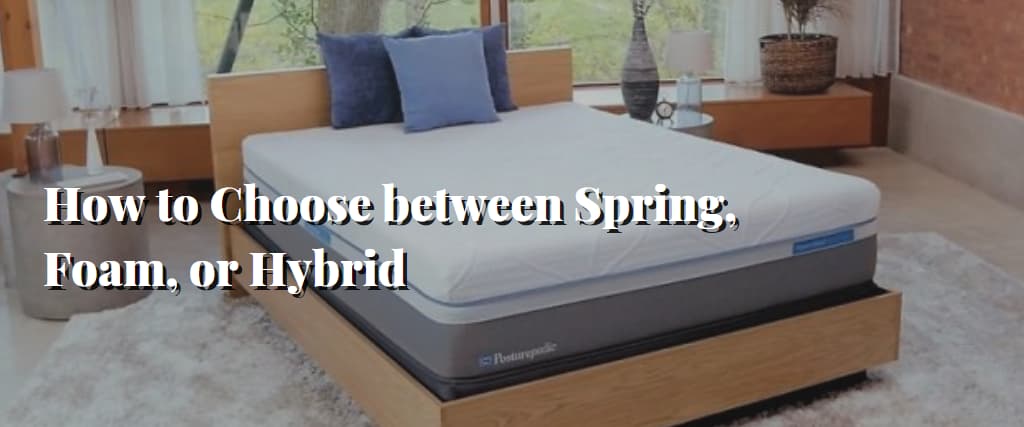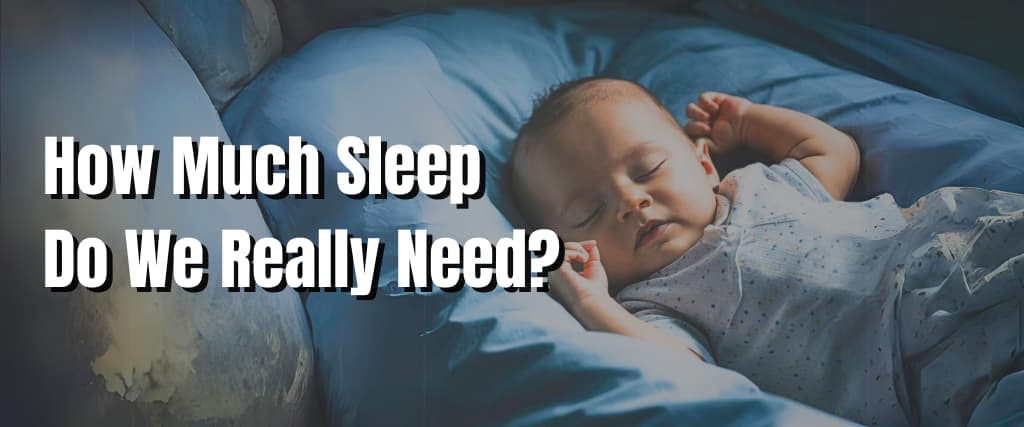As a child, there was a struggled with falling asleep due to the tendency of the mind to wander in various directions. One of the subjects that piqued interest during these nocturnal musings was the mechanics of everyday household items, such as the construction and function of taps.
However, this late-night curiosity did not translate into practical daily life benefits. Instead of seeking answers to elementary school queries, the rise of YouTube resulted in a preference for watching videos of puppies.
Knowing what you’re purchasing makes sense, especially if you plan to make a sizeable deposit. And you need to know what mattresses are composed of to comprehend what you’re buying, how it functions, and what features you individually desire in a bed.
The article on mattress types offers a quick summary of the numerous mattress classifications and a bed’s two most important components. This post will delve into more detail regarding both aspects and examine how the available resources can affect your sleep quality.

The Two Sections Of A Mattress
The cushion, or comfort layer, and the core, or support layer, comprise a mattress’s two primary parts. The layers serve as support and comfort, respectively, as their second names suggest.
A mattress should equally distribute your weight and maintain the alignment of your spine as you sleep.
For instance, consider the side-lying human body. Due to the lack of support, the waist would drop down, and you would lift the head and shoulders if someone were to lie on their side on the bed.
In this position, their spine would sink toward the ground if you were to observe it. Moreover, the hips and shoulders would support the whole weight of this individual. Consider the length of time you can remain on your toes.
Your toes cannot hold the weight of your complete body for long. Similarly, carrying your entire body weight all night is bad for your hips and shoulders. This individual would probably wake up stressed and aching if they were resting on the floor.
The perfect mattress supports your body while letting your hips and shoulders sink into it for comfort. This ensures that your load is appropriately distributed around your body and reduces any pressure spots.
The comfort layer is the mattress’s top layer and distributes your body weight evenly while providing comfort. It will help if you become buried in this stratum. It’s soft and is constructed of quilted or foam materials.
How far into the bed you go is determined by the support layer. This is the layer that the comfort layer encloses. It supports the body components that must rest higher up and allows some sections of your body to go deeper down than others, keeping your spine straight.
To achieve optimal sleep, it’s essential to find the best mattress system that suits your body and fits within your budget. Understanding the various components of a mattress and how they work together will enable you to determine whether a particular system suits you.
Therefore, it’s crucial to look for a high-quality bedding system that can offer maximum comfort and support for your body.

The Comfort Layer/Upholstery Layer
Many mattresses feature many layers of material in the comfort layer, allowing for customisation and using the various benefits that various materials may provide. This layer frequently contains three types of foam: polyfoam, latex foam, and memory foam.
Moreover, mattresses made of organic or natural materials like wool or cotton and gel foams are available. Mattresses with pillow tops or Euro tops make up the final group.
Although the comfort layer is the one you lie directly on, they sit on top of it but should still be covered in this portion of the text. We shall briefly discuss pillow tops and Euro top beds because their producers contend that the additional layer makes for a more pleasant sleep.
Comfort Layer – Foams
Foams are often used in bedding because they can adapt to the shape of your body. Doing this cradles your body, distributing your weight evenly over the sleeper’s height. Memory foam is ideal for side sleepers since it works wonders at easing pressure spots by closely mimicking your shape.
Instead of lying on the mattress, it will feel more like you are sleeping inside it. You may see it as a plaster cast of your body. Yet memory foam sags far more readily and is less resilient.
Memory foam and polyfoam are similar, but polyfoam is more responsive. It will recover right away. If the polyfoam is not high density or high resilience foam, and if it is not of acceptable quality, durability and sagging will occur sooner rather than later.
Because latex foam is so bouncy and rapidly goes back to how it was, it will be especially beneficial for those who move a lot while they sleep and those with mobility issues. For stomach sleepers, it is ideal since it is firmer than memory foam. It won’t feel like you’re sleeping inside of it so much as on top of it.
A gel foam bed is made of memory foam with gel infused. Since that memory foam absorbs heat independently, the gel bed can benefit people who tend to sleep hot. Gels draw heat from the body towards the mattress’s centre.
Yet, the gel granules might come loose from the foam and endanger the mattress’s structural integrity. There are also gel mattresses with a layer of gel close to the top that might solve this issue.
Yet, although the gel is initially chilly to the touch in both instances, many individuals discover that it eventually warms back up. This is because the gel only transfers heat; it does not, by itself, emit coldness.

Comfort Layer – Organic/Natural Materials
A wide range of materials can be considered organic and natural. Latex foam, wool, and cotton are the most often utilised materials, although many other plant fibres and animal hairs, including horse and camel hair, can also be employed.
All I’ll mention about latex foam is that it is available as synthetic latex or all-natural latex, as discussed before. Be sure the latex mattress you’re thinking about is natural latex rather than synthetic latex if you’re searching for a bed built with natural ingredients. But be mindful that organic latex can’t be considered organic.
Wool and other natural fibres tend to be relatively firm with some bounce. As the material isn’t softened, a person’s weight gradually condenses the bed over time.
The significant advantage of organic or natural products is that they are kinder to the environment because they are manufactured from sustainable materials, are biodegradable, and don’t include synthetic chemicals that might cause physical responses and health issues.
While some materials—typically wool, cotton, and coir—are more breathable than others, latex foam is unquestionably not one of them.
Micro Coils
Micro coils are just as little as their name suggests. They are frequently utilised in the upper comfort zones of premium standard beds and occasionally in the top pillow region of pillow top beds.
By utilizing coils that press upward and downward to redistribute your weight equally throughout your body, these small coils seek support and comfort, like pocket spring mattresses.
Coils bounce back, preventing body imprints from lingering in the bed and extending the life of the mattress. Also, the coils allow for better ventilation than a foam layer, which helps overheated sleepers keep cool all night.

Comfort Layer – Pillow Top/Euro Top
Pillow-top mattresses indicate an additional comfort layer placed on the top of the bed; they don’t refer to the material used inside the mattress. Most mattresses have tape edging on the top and bottom.
A pillow-top mattress stands apart from other beds because it has an extra tape edge, and between that edge and the top tape edge, there is stitching that gives the mattress its pillow’s entire appearance.
Similar ideas underlie the idea of a Euro top. The bed is straight from top to bottom and has three tape edges instead of the usual two due to the lack of an indentation.
Since they are often denser than pillow tops, Euro tops are marginally more durable.
The additional padding and fluffiness may be preferable for certain persons, especially side sleepers. Individual tastes play a significant role.
Nevertheless, pillow tops will be less resilient than regular mattresses, and drooping in the pillow and Euro top will occur more quickly than it would otherwise.

The Core Layer/Support Layer
The mattress layer that offers support is commonly known as the support layer. This layer can contain various materials such as foam, latex foam, springs, water, or air.
Understanding the differences between these materials is essential, as each can provide a distinct feel and level of support to the sleeper.
Core Layer – Foams
Both a core and an upholstery layer can be made of latex foam. It can adapt to the sleeper’s shape and is solid, durable, and relieves strain on the neck and spine. As with a rubber ball, latex will rebound more quickly than memory foam.
There are several hardness options and quality levels available. Dunlop and Talalay latex are the two varieties of latex foam used in mattresses.
These two kinds of latex are identical but produced differently to achieve distinct outcomes. Many mattresses will employ a combination of memory foam and latex foams to tailor the bed’s softness and hardness and decide how supportive the bed will be.
Because of the Dunlop’s high density, it is incredibly robust and supportive. Nevertheless, hot sleepers typically like the Talalay because the thick Dunlop latex absorbs more heat.
Since it softens with pressure or body heat, memory foam is rarely utilised as a core layer. Yet, because polyfoam recovers fast, it resists and supports the human body’s weight.
Since polyfoam may be highly supportive and can be produced in various stiffness degrees, it is frequently utilised as a core layer. While standard polyfoam is not a high enough grade to be a support layer, ensure the mattress includes high-density polyfoam (H.D.) or high-resilience polyfoam.
Even if the bed’s core is made of innerspring or another material, you could discover that polyfoam is frequently utilised as edge support to prevent you from falling off the bed.
Core Layer – Innerspring
The springs of innerspring beds, whether bonnell spring or pocket spring, support the body. The coil or spring count, the working turns (or how tightly the locks are twisted), and the coil gauge affect how strongly the springs push back to support the body.
It could be more supportive if your weight is distributed over a more significant number of springs because each coil only supports a smaller portion of it individually.
With more turns, each coil offers greater support from an additional wire. As a result, it is thicker and sturdier than most other springs. Moreover, how individual locks are connected or detached can determine how much weight they can carry and support your body while in use.
In contrast to independently standing coils, where your weight pulls down just on the locks physically holding you up, linked coils distribute your weight more evenly throughout a more significant number of coils.
Core Layer – Water
The mattresses made of water are cozy. It’s like sleeping on waves, which many find comforting. Some believe waterbeds facilitate proper spinal alignment, enhancing blood circulation and lessening pressure points. Some believe it fails to support the joints.
Core Layer – Air
Those who suffer from bed sores, back discomfort, or other types of joint pain could benefit from using an air mattress. The bed’s firmness may be changed, which is the fundamental explanation. Add additional air for a firmer bed.
Deflate the mattress a little to make it softer. An air bed, however, could be more comfortable for many individuals. It lacks the support that a traditional bed can provide, and by gradually deflating the mattress, you give up hardness for a mattress that fits your shape.
Core Layer – Organic/Natural materials
In many organic mattresses, the support layer is made of latex foam, perhaps with a layer of coir added. With innerspring mattresses, Bonnell springs are typically used rather than pocket coils, which employ polyester pockets to wrap each lock.
Mattresses made entirely of wool, or several specialised producers produce organic cotton. It is typical for mattresses wholly composed of cotton or wool to be firmer. The fibres from coconut husks, known as coir, are another material that you may utilise in the core layer on natural mattresses and is reasonably complex.

How to Choose between Spring, Foam, or Hybrid
The type of mattress you prefer—a spring mattress, a foam mattress, or both—also referred to as a hybrid mattress—should be decided upon first.
The following information can help you choose between foam, spring, and hybrid:
Innerspring Mattresses
The spring mattress is the most common form of bed and comprises a layer of coils encircled by layers of comfort material, which may be latex, natural fibres, or foam. Multiple spring mattress types use various coils and patterns to provide different results.
Advantages
- provide reliable back support
- a large variety of firmnesses available
- Some choices are affordable.
Disadvantages
- may degrade quicker than foam
- Spring noise might increase with age.
- Reduce joint pressure alleviation.
Spring mattresses are frequently the best option for people who like to sleep on their stomachs or backs, have lower back discomfort, or are heavier and find that foam mattresses don’t provide enough support.
Foam Mattresses
Foam mattresses use various mixes of various-density foams to give softness and support, and they were widely used when NASA developed memory foam in the 1970s. Although latex foam is the most popular kind of mattress, there are other sorts as well that have various advantages.
Advantages
- Absorbs movements of restless sleepers
- Springlessness eliminates loudness.
- longer-lasting than spring mattresses
- , more accommodating to side sleepers and anyone with joint pain
Disadvantages
- Certain foams retain body heat.
- Softness might give off a sinking impression.
- inadequate support for some sleeper kinds
- More costly than mattresses with springs
A foam mattress is frequently the most excellent option for side sleepers and people with joint pain and discomfort.
Hybrid Mattresses
Some mattresses have a hybrid design that combines layers of foam and springs. Hybrid beds can be a fantastic alternative for people whose tastes fall between spring and foam mattresses.
Advantages
- Softer than springs without the “sinking” feeling of foam pressure point relief without sacrificing back support
- Usually quieter than spring bed alternatives
- Greater temperature control than mattresses made entirely of foam.
- It may be used by partners who desire varying levels of stiffness.
Disadvantages
- More expensive hybrid mattresses can be of higher quality.
- Not as effective at absorbing motion as foam
For couples and those who want the firmness of a spring mattress with the comfort of a softer alternative, hybrid mattresses are frequently the ideal option.
The Casper Original, Nova Hybrid, and Wave Hybrid are just a few of Casper’s hybrid mattresses.

Toxic Chemicals And Materials To Avoid In A Mattress
Most individuals lie on a mattress for at least seven hours each day. Consider the potential consequences of spending so much time on anything that uses hazardous materials and chemicals.
Petroleum-Based Chemicals
Many mattresses include polyurethane foam, which comes from petroleum. “off-gassing” refers to the process by which volatile organic compounds, or VOCs, escape from conventional polyurethane foam and into the atmosphere.
Have you ever noticed the unpleasant scent of a brand-new mattress? You never know. Those with chemical allergies or respiratory disorders like asthma may also become irritated.
Chemical Fire Retardants
New federal regulations were published in 2007 by the U.S. Consumer Product Safety Commission (CPSC) to guarantee that mattresses can resist the requisite 30 minutes of exposure to an open flame.
While many mattress manufacturers utilise chemical treatments to achieve these requirements, some still need to. Your best option if this is a serious worry for you is to get a mattress produced in the United States. Beds created in the United States are subject to stringent safety rules restricting the use of dangerous or poisonous substances in production.
PBDEs
This is important to know whether you’re buying a secondhand mattress or already own one from 2005. Another category of chemical flame retardants is polybrominated diphenyl ethers (PBDEs), although they have been prohibited in the U.S. since 2005.
The U.S. Environmental Protection Agency claims that studies on rats and mice have shown PBDEs to be hazardous to the developing nervous system and the thyroid. Does this imply you should eliminate that mattress of yours? Although it might only sometimes be beneficial for you to do so, you should give it some thought.
Eco-Friendly Mattress Materials To Look For
Some mattresses have best environmental practices in the materials and manufacturing processes than others. Consider these widely used, non-toxic materials if you choose an environmentally friendly bed.
Wool
Wool is naturally flame resistant due to its chemical composition. It is hypoallergenic, dust mite resistant, and antibacterial and antimicrobial.
Organic Cotton
Soft and airy, cotton flannel is also hypoallergenic. Also, because organic cotton is cultivated without chemical pesticides or synthetic fertilisers, it doesn’t damage waterways with chemical runoff.
Greener Foams
Traditional foams can potentially “off-gas” or release a gas containing a chemical, sometimes dangerous. Seek for foams made with plant-based materials rather than ones with petroleum byproducts. Consider purchasing foams with third-party certifications, such as Oeko-Tex, CertiPUR-US®, and Greenguard.
Latex
Latex is a natural product derived from the rubber tree’s fluid. Natural latex is allergic, recyclable, and not off-gas. Materials derived from petroleum are used to make synthetic latex mattresses.
Final Thoughts
Finding the finest mattress “system” for your body within your price range is critical to getting the best sleep possible.
You may better comprehend the type of system you’re searching for by understanding the materials used in mattresses and how their distribution throughout the mattress affects how a bed functions.
You may confidently further focus your bed search after trying a few options to get a sense of what feels comfier.






